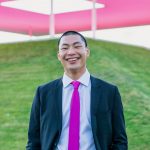 Alex Hwang
Alex Hwang
Home University: Rice University
Field of Study: Electrical Engineering and Minor in Physics
Current Status: Sophomore
Expected Graduation Date: May 2019
Host Lab in Japan: Kyoto University – Institute of Advanced Energy, Matsuda Laboratory
Research Project: “Exciton linewidth effect on valley relaxation in 2D TMDCs” (PDF)
Why Nakatani RIES?
Nakatani RIES has been my dream program for this summer because of the way it perfectly merges a rich study abroad experience and a serious research experience in nanoscale science. This internship presents the amazing opportunity to explore Japan, an exciting, innovative country rich in culture and tradition. I’m excited to go to Japan and compare what I see to my own Asian cultural heritage and experience. In addition, this program perfectly aligns with my career goals and research interests: I want to pursue a career in research in nanoscale science and engineering, especially with interesting, novel nanomaterials. As my mentor from Rice, Professor Naik, has told me, there is no better place to study materials than Japan. I’m so excited to be part of a program that creates a uniquely holistic, immersive research experience that will train me to become a more mature researcher. The research of the future will be of global scale, crossing many cultural bounds, and I’m so eager to become immersed in it this summer.
Goals for the Summer
- Work as hard as I possibly can in the lab, keeping in mind that 9 weeks of research will fly by
- Practice zazen (Zen Buddhist seated meditation) daily and visit a Zen Buddhist temple
- Hike Mt. Fuji
- Make meaningful and lasting friendships with other Nakatani fellows and colleagues in my host lab.
Meaning of Nakatani RIES (Post-Program)
Being a participant in the Nakatani RIES Fellowship was one of the most rewarding experiences of my life to date. I experienced a huge amount of growth as a scientist, working in a cutting-edge research laboratory where I was challenged to work hard on a demanding research project. In doing so, I made numerous international connections and gained cross-cultural experience working in a large, international laboratory group, which I feel will be invaluable as I continue my scientific career in a world that is becoming more and more globalized. At the same time, I experienced the most personal growth in a short period of time than I have ever before. Living independently in Japan and being immersed in the many aspects of Japanese culture that contrast strongly with those of American culture taught me much about my own personal values and beliefs. As such, I not only became more confident in my abilities as a scientist and a leader, but also felt myself develop into a more empathetic, patient, and mature person.
Daily Life in the Lab
This summer, I worked in the Matsuda Laboratory at Kyoto University’s Institute of Advanced Energy. I primarily worked with Wenjin Zhang (PhD student) and Prof. Yuhei Miyauchi (Associate Professor). My project was to examine mechanisms of losing “valley” information at low-temperature in 2D transition metal dichalcogenides. These 2D TMDCs are a class of modern nanomaterials that can store information using the “valley” degree of freedom that is probed using the circular rotation of incident light.
In doing so, I gained a large amount of experimental experience that will be extremely valuable to my future career. I learned about exfoliation techniques for 2D nano materials and learned how to mechanically create 2D material heterostructures. I became proficient in using photoluminescence and Raman spectroscopy to characterize 2D nanomaterials. Finally, I operated a complex laser spectroscopy setup at cryogenic temperatures and took complex measurements such as polarization-resolved photoluminescence spectroscopy and time-correlated single photon counting. These techniques span a wide range of disciplines, from materials science to optical physics, and will be extremely useful to me as I explore my scientific interests. In addition to these experimental techniques, I also gained a lot of experience using MATLAB to analyze lots of experimental data and generate publication-quality figures.
My laboratory in Japan felt like a second home, and I was very sad to leave it. The lab has people from all over the world (Japan, America, China, Malaysia) who speak many different languages. Being a member of the group was extremely intellectually stimulating because of weekly journal club sessions and textbook reading sessions. I was very lucky to have incredible mentorship available to me in the lab. My PhD student mentor was extremely kind and not only helped me deal with everything relating to my project but also met me at Kyoto Station on my first day and helped me move in. The overseer of my project, Miyauchi-sensei, spent a lot of time helping me with anything related to my project and having lots of discussions about my results. Matsuda-sensei, the head of the lab, also made sure I had all the resources available to me in the lab to help me succeed and gave lots of advice and guidance on both my project and a scientific career in general.
Daily Life in Japan
On the average day, I would work hard in the laboratory for most of the day. I would enjoy getting lunch and dinner with both my professors and labmates at the Kyoto University cafeteria. Occasionally, I would cook simple meals for dinner. On weekends, I would usually relax a little and enjoy the cultural richness of the Kansai region with my Japanese friends or American friends from the Nakatani program. Some of the highlights included taking a day trip of Nara, exploring the food scene of Osaka, seeing the temples and shrines of Kyoto, and experiencing the major festivals Gion Matsuri and Tenjin Matsuri.
Experiences with Japanese Culture
One of my favorite experiences in Japan was the farewell party my lab held for me at an okonomiyaki restaurant in Kyoto. This experience really helped me understand the group-centered culture of our Japanese lab and made me appreciate the many friendships I made in my research laboratory. In particular, I joked and had fun with the Japanese members of my lab, and appreciated the fact that though these friendships took a little longer to form, I felt like they had more meaning and weight by the time they did. As I talked to my Japanese professors, I felt so appreciative of the kindness and support they gave to me, basically a stranger, in their laboratory.
- My favorite experience in Japan was… my farewell party with my laboratory, where I realized that I had made some incredible life-long friends and potential future collaborators and where I felt an immense sense of gratitude for everything Japan and this internship have provided for me.
- Before I left for Japan I wish I had… thought more carefully about the kinds of places I would like to visit. Japan has so many exciting places to visit, so it takes time to sort through them and organize trips.
- While I was in Japan I wish I had… been more confident in interacting with my Japanese lambastes who didn’t speak much English. At first, I didn’t think they were interested in hanging out, but by the end, I realized that they probably thought the same about me because I wasn’t active in reaching out to them.
Excerpts from Alex’s Weekly Reports
- Week 01: Arrival in Japan
- Week 02: Language Learning & Trip to Mt. Fuji Lakes
- Week 03: Noticing Similarities, Noticing Differences
- Week 04: First Week at Research Lab
- Week 05: Critical Incident Analysis – Life in Japan
- Week 06: Preparation for Mid-Program Meeting
- Week 07: Overview of Mid-Program Meeting & Research Host Lab Visit
- Week 08: Research in Japan vs. Research in the U.S.
- Week 09: Reflections on Japanese Language Learning
- Week 10: Interview with a Japanese Researcher
- Week 11: Critical Incident Analysis – In the Lab
- Week 12: Final Week at Research Lab
- Week 13: Final Report
- Follow-on Project
- Tips for Future Participants
Week 01: Arrival in Japan
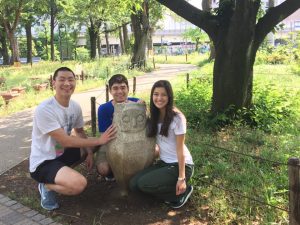
Initial impressions
It’s difficult to capture the extent to which I have already fallen in love with Tokyo and Japan. Tokyo is a city bursting with excitement, with so many novel things to explore and discover. The public transportation system here makes quick travel a breeze, and basic Japanese proficiency can take you a long way in terms of communication ability. At the same time, Tokyo clearly has deep traditional roots dating back to its inception in the feudal days of Japan.
Before we traveled to Japan, our group had discussed at great length about cultural differences we might experience once we travelled. Even with this, and even though I have an Asian heritage and have traveled to several other Asian countries, I was very surprised by many of the things I noticed once I came to Japan.
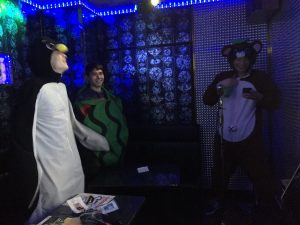
The first obvious thing to notice is the cleanliness, order, and timeliness of this city. It’s incredible that a metropolitan area of this size and industrial capacity is so ridiculously clean. There are no public trash cans (but litter is nowhere to be found); subway trains are never late; and people are always on time to appointments. Every small detail of Tokyo feels like it was planned out for some purpose.
Another thing that I’ve noticed is the kindness of the people here. Professors, teachers, university students, convenience store workers, hotel staff, store owners — you name it — have all been so incredibly welcoming to the Nakatani students and me. I didn’t really believe it when I heard it before coming to Japan, but it is true — people will go out of their way to walk you to a destination if you ask for directions and they will call you to return your wallet if you leave it on a subway train.
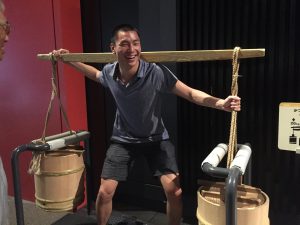
First activities
Our first week of introduction to Japanese society and culture has been a whirlwind of activity. We had an excellent introduction to the topic from our very own leader within Japan, Ogawa-san. It was extremely meaningful to be introduced to the cultural elements of this society from someone who has spent his entire life in Japan, but who also has worked in many global environments in several different countries. He introduced us to the idea that the Japanese seem to value relationships more than Americans, especially because their grade-school friends may well be their friends for life, and it’s common for people to work only one job after graduation.
On the other hand, we received a fantastic cultural introduction to Japan from Mr. Cain Gibbs, an American who has been living in Japan for the past 9 years to teach in the public-school system. His talk was candid and honest, and it made me extremely excited to dive deep into Japanese culture and immerse myself with Japanese people. He encouraged us to live outside our comfort zones while spending the summer in Japan and try to do something new each day. He reminded us to pursue real connections with Japanese people, even if there is initial discomfort or language barriers in doing so. I hope to take his advice seriously this summer and immerse myself in this brilliant culture.
The highlight of my week so far has been attending a festival at Todai (The University of Tokyo), called 5月-さい (May festival). We were actually invited by a master’s student from Todai who we met during our visit to the University of Tokyo and discussion session with Tabata-sensei’s lab, to come, and I’m so glad we did. The festival was one of the largest gatherings of people in a small space that I’ve ever seen, and it was also one of the liveliest gatherings I’ve ever seen. The festival was unlike anything I’ve experienced in the US — the energy from all the people was so palpable in the environment. Hundreds of student groups and clubs from Todai had stalls selling street food, drinks, desserts, and other various items. There was an incredible student origami display, makeshift rock bands and their audiences packed into stairwells and classrooms, and an incredible J-POP performance in a main outdoor auditorium. My friends and I actually talked to a few Todai students there, and a couple of us even exchanged contact information to join sports clubs and such. To say the least, I wish that schools back at home had things akin to this. It was amazing to see the collective energy of this festival and joy that came because of it.
Language progress
Learning the Japanese language has been an absolute blast. I was placed in Class 2 with Trevor, and we’ve made so much progress in the past week with our many extremely kind and helpful language teachers. After the first day, I was surprised by how much of the Japanese I had previously studied that I recalled. Being immersed in the culture and context of Japanese seemed to have turned my brain “on” again for the language, and I have surprised myself at how well I’ve been able to communicate. It’s quite easy to get around if you have studied Chinese (which I have) and you can read katakana, which are characters that basically help you “sound-out” foreign words. Armed with these and a lot of Japanese I’ve practiced in class, I feel extremely confident in my very basic Japanese already. One goal I have moving forward is to become a more conversational speaker and pushing myself in class to ask questions that will promote casual conversation.
Question of the Week
I’ve heard a lot about “indirect speech” before coming to Japan, but I haven’t really noticed it much. Will this become something important to think about in a research setting? How can I pick up on “indirect speech” cues?
- You may not have heard this yet as you are still a beginning language speaker and the indirectness of the language really does require more fluency with keigo and other polite forms. However, you may have noticed that you will rarely hear ‘No’ in Japan. Instead, you may hear someone say, “Hm, perhaps that maybe could be a bit difficult.” Or simply a teeth sucking noise which may be as close as you come to a firm no. You will likely encounter this in your lab when, if you ask what time you should come to lab, some people may say things like, “It is up to you.” To an American, you would likely accept this at face value but, in Japan, the correct thing to do would be to follow-up and ask, “Hm, perhaps it would be good for me to be at the lab when you are. What time will you plan to be in the lab tomorrow?” as truthfully, your mentor may expect you to ask this and you should try to arrive a bit before they do. You may also not get a direct answer to the question, “What time can I leave the lab?” in the same way. Rather, you may just need to watch and observe when your mentor leaves that lab to get a better sense of what might be best given the culture/working times of your lab. It is indirect, because you are supposed to know that you should ask a follow-on question. Also, people may not phrase thing as a specific request, but rather as a question or suggestion. For example, “Perhaps we should move the tables into a square or classroom style. What do you think?” Here are a few more resources on indirectness in Japanese communication that you might want to also review.
Research Project Introduction & Paper Summary
Before departure, we had an extremely thorough introduction to Japanese culture in the context of this research internship from both Sarah-san and Kono-sensei. Sarah-san’s lecture was extremely relevant because of her extensive experience running research programs abroad, and got me thinking about important goals to have while pursuing research that crosses cross-cultural bounds. Kono-sensei’s introduction to research was extremely exciting, and helped me understand that an undergraduate, with enough hard work and diligence, can definitely have a research impact in programs and collaborations such as these.
I have described many aspects of the planned week 1 sessions in my cultural overview above. One thing I didn’t include was a talk from Professor Nishikawa, a professor emeritus at Kyoto University. His talk was very intellectual stimulating, especially because of the passion it conveyed about the life sciences, a field that my studies were not focused on. It helped me consider that connections between my research interests in electrical engineering and physics and connect them to the grand challenges and opportunities facing humanity today, from the introduction of big data into peoples’ everyday lives to genome engineering to artificial intelligence to rapid international collaboration.
Another awesome thing we did was visit Todai and tour some of the amazing research facilities they have for nanofabrication and nanocharacterization. Tabata-sensei’s group was incredibly kind to give us this tour and talk to us afterwards, and I know we were all incredibly grateful for this opportunity. This trip really emphasized to me the raw power of collaboration, especially if Japan is involved, because its resources devoted to cutting-edge nanotechnology equipment is astonishing, especially compared to the much smaller equipment resources we have at Rice.
I am extremely excited to be working in the Matsuda Laboratory this summer, part of Kyoto University’s Institute for Advanced Energy. The Matsuda Lab specializes in optics at the nanoscale, and, according to Professor Kono, is one of the world’s finest labs in nanoscale material optics. This is somewhat familiar territory for me, as I’ve been a member of the Naik Laboratory at Rice University, which focuses on photonics (mainly plamsonic applications) of nanoscale materials. I’m excited to learn as much as I can about optics and materials this summer and bring all that I can back to my young group at Rice.
I have been assigned a PhD mentor in the Matsuda Lab, and my project will be focused on the optical properties of a class of two-dimensional materials called transition metal dichalcogenides (TMDCs). I am very excited for this opportunity because I have been doing research on two-dimensional materials at Rice (2D alternative metallic nanomaterials for visible-range plasmonic applications). Two-dimensional materials are classes of nanoscale materials that are either atomically-thin (monolayers) or contain very few atomically-thin layers (bilayers and few-layered ultrathin materials). The most famous example of a 2D material is graphene, and its incredible optical, electrical, mechanical, and thermal properties have led to a whole new paradigm in materials science, that of atomically-thin materials. 2D materials are extremely promising for use in optoelectronic applications. Because they are so thin, they interact very strongly with light. In addition, their thinness lends themselves to strong interactions with their surrounding environments, making gate-, stress-, and thermal-, and magnetic-tenability realizable.
Though the great majority of 2D materials research has focused on graphene, it has one downfall: it has no bandgap energy. (In most situations this has true; it can be tuned to have a bandgap energy through external fields, but this limits its high carrier mobility). 2D TMDCs are a solution to this problem: many of them (the most famous being MoS2) are semiconducting and have direct IR-to-visible bandgaps when they are monolayers. Direct bandgaps are wonderful for optoelectronic applications because interband transitions can satisfy momentum- and phase-matching conditions. The concept of bandgaps in semiconductors is what has led to essentially all of modern computing and technology: without bandgaps in silicon, gallium arsenide, and other popular semiconducting materials, the transistors, diodes, and junctions that rule our society would not be possible. 2D TMDCs offer a bandgap with all the benefits of the nanoscale.
Another reason that 2D TMDCs are interesting optically is because they have strong conduction-band valleys at separate points in reciprocal space. This is interesting for the field of valleytronics because electrons/holes residing in these valleys (conduction band minima/valence band maxima) can carry information in a new type of way. The momentum of the electron now carries information (what the valley the electron resides in k-space determines its momentum/wave vector). I was extremely excited to learn about this because the concept of valleytronics was extremely new to me. One amazing thing is that differences in circular polarization of incident light onto a material like 2D MoS2 can change the “valley polarization” of its current (the extent to which the current is distributed into one valley over the other), and that the valley polarization of the current can influence the circular polarization of photoluminescence! In essence, light (more specifically, light’s polarization) is the secret key to manipulate this novel way of transmitting information through different electron momentum in currents.
My PhD mentor has done work on 2D semiconducting TMDC monolayers and their excitonic properties. Excitons are bound electron-hole pairs (EHPs) that have a smaller binding energy than the interband energy gap but can have long carrier lifetimes in materials with high Coulombic interactions. Sometimes, if carrier interactions are particularly strong, trions will form (they do in MoS2 and MoSe2!) that have an extra carrier contained in them. I also am a total newbie to excitonics, but I am excited to learn about these carrier dynamics because of their important relation to valleytronics and other novel, futuristic schemes.
Paper Summary
I will summarize a manuscript that has recently been accepted in Nanoscale that my PhD mentor contributed to on 2D TMDC excitonics in simple heterostructures.
One of the most exciting ways to utilize the 2D materials I have described in the above section is to exploit their extreme sensitivity to their environments in heterostructures (basically, many 2D materials layered on top of each other). This provides an incredible way to tune the optical and electronic responses of 2D materials by strategically crafting a proper 2D “sandwich.” These heterostructures are often extremely difficult to produce in practice, but are the topic of much research interest in the field. This paper describes the excitonic carrier dynamics that occur between monolayers of MoS2 and MoSe2. Excitons (and trions) in these materials have extremely high binding energies compared to traditional semiconductors, which makes them even more exciting for novel semiconducting applications. These new materials make the futuristic idea of excitonic circuits feasible, so it’s an extremely pressing issue to study their excitonic properties carefully.
The Matusda group used a technique called photoluminescence spectroscopy (PL spectroscopy) to study exciton dynamics in these simple 2D systems. This is an important technique that I’ve seen often in the literature that I have had no experience with and am excited to learn more about. Basically, PL spectroscopy relies on the way incident light (at different frequencies) interacts with a semiconducting structure with all sorts of energetic happenings such as interlayer transitions, excitonic/trionic excitations, and phonon modes. Much of the paper carefully argues that the lab has correctly characterized a unique inter-layer excitonic mode that occurs when monolayers of MoS2 and MoSe2 are stacked together. To do this, it was important for them to run all characterizations for the separate monolayers and for the bilayer structure. In addition, exploiting the unique tunability of 2D materials, they created a gate-tuning mechanism (similar to a basic MOSFET) that tuned the carrier concentration of the system. By tuning the gate voltage, they were able to characterize the nuances of the inter-layer excitonic response in this structure. I have had no experience with nanoscale device fabrication and would love to learn more about how they like to run experiments with gate tunability and fabricating basic devices.
Using such techniques, the authors were able to characterize inter-layer excitons and trions in this bilayer structure, including their decay time and binding energy. I would love to learn more about what simulation tools the Matsuda lab uses to compare their experimental observations to theoretical results. Simulation tools are powerful methods of exploring this new physics, and I would love to get a more theoretical understanding of this while I am a student in their lab this summer! I am beyond ecstatic to dive deeper into this area in one of the best optics and materials labs in Japan at one of the most prestigious universities in the world!
Week 02: Trip to Mt. Fuji Lakes
Japanese language classes have still been a blast — Trevor and I have been learning many unfamiliar verb and adjective conjugations that have enabled us to construct more complicated sentences and questions. The highlight of this week in terms of language was visiting the office that our Japanese language teachers work at (AJALT) and having a 45-min Japanese conversation with a sensei we had never met. I gained so much confidence in my language abilities after being able to learn about and introduce myself to a completely new Japanese person! During our amazing weekend trip with the Japanese fellows, I was able to speak a decent amount of Japanese; this was super exciting! I could tell they really enjoyed when we try to speak Japanese, and often our broken Japanese helped bridge some communication gaps when neither party could find a word. Looking ahead, I want to improve my ability to talk about my research in Japanese, because many times I’ve been asked to talk about my research, but many English terms I use have been unfamiliar to Japanese people.
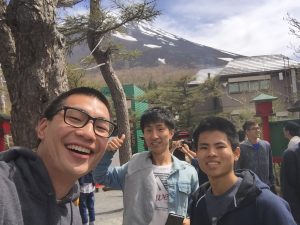
Weekend trip to Mt. Fuji Lakes
The weekend trip to the Mt. Fuji lakes area was by far the best experience I’ve had in Japan so far! Everything we did was so so incredible. After we met the Japanese fellows (the coolest people I’ve ever met, by the way) at our hotel, we traveled by bus to the 5th station of Mt. Fuji. After looking around, we had an amazing tempura udon lunch. We did some more sightseeing around Mt. Fuji, then had an awesome buffet (where I ate 30+ pieces of sushi) at our hotel. We got many of the Japanese and US fellows to go to onsen (traditional Japanese hot spring) together, which was an awesome bonding experience (no clothes allowed!) and so relaxing. Afterwards, we had all the fellows over for late night bonding in our room. It was a great time. On Sunday, we did a lot of sightseeing on the way back, from a beautiful bridge with a beautiful 360-degree view to a strawberry-picking farm. Oh, and we had lunch at the most amazing seafood barbecue/sashimi place I’ve ever been to.
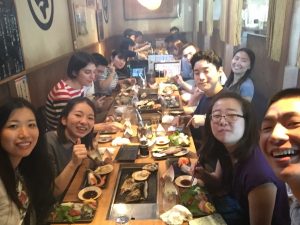
I was nervous before the weekend about meeting the Japanese fellows, but, from the beginning, they were so warm and open to us. We all started bonding instantly on the bus ride over, and it was (and is) clear to me that they are all so ridiculously amazing people. However, it wasn’t always easy to converse with them. Because the Japanese fellows had to meet not only the Japanese fellows but also the US fellows at the same time, I could tell they were, understandably, at times, overwhelmed with meeting and socializing with so many people. Even though all the Japanese fellows spoke perfect English, there were times when a particular English phrase or word caused some communication blocks. Mindful that many Japanese people can be taken aback by the eagerness of Americans to keep blabbing, I tried my best to navigate being my outgoing self and understanding when they preferred silence. Still, I do feel like I made some incredible Japanese friends this weekend and had many awesome conversations. I enjoyed every conversation topic, from physics to feelings of nervousness about going to a new country — I loved being able to connect to other university students from a completely different background, sharing similarities and bridging differences. This is one aspect that makes this Nakatani program so unique and special. I learned much about how universities in Japan operate and how they compare and contrast to US universities. I was especially interested in the Japanese fellows’ opinions on hierarchy and how undergraduate students fit into the academic hierarchy here. Not only did I make some amazing friends, I also got to learn so much about Japanese universities from the best source possible: Japanese university students themselves.

Overview of Week Two of Orientation Program
This week, even before the Mt. Fuji lakes trip, was a whirlwind of activity and fantastic outings. On Monday, we visited JAMSTEC, a “Marine-Earth Science and Technology” center that does advanced research on earthquakes, an extremely pertinent issue to Japan. It was fascinating for me to see how much advanced algorithmic signal processing and network engineering that goes into dealing with this problem that has such tangible connections to people and their well-being. On Wednesday, we had a lot of fun at a Taiko drum workshop (but ended up with very sore arms afterwards). Afterwards, I introduced the Japanese cultural cornerstone that is UNIQLO to dad for the first time. (Aaron is now known to both the US and Japanese fellows as “Dad” because he is the perfect archetype of a dad).
On Thursday evening, we had a wonderful discussion about bridging cultural differences, led by our one and only leader, Sarah-san. I loved getting the chance to meet even more Japanese students and discuss. Afterwards, some of us all had a lovely ramen late night snack together! It struck me when I asked one female student why she didn’t want to be a professor and she replied, “Of course I don’t want to be a professor? There’s no way I would fit in.” This was the first immediate moment for me where I began to think about the complicated relationship between science and culture in Japan.
Our final cultural session of the week was a guest lecture about the kimono, its historical significance, and ways of bridging the traditional and the modern in Japan’s current and future society. This talk was one of my favorites that we’ve listened to, and I was so inspired by our speaker, Kento Itoh, his vision for connecting the world with the kimono and his encouragement for us to think about and connect with culture on a daily basis.
Question of the Week
A lot of the Japanese fellows I met this week told me that they were much more interested in being researchers in industrial/governmental labs than academics. Is there a big difference between the work preferences of researchers in Japan and in the US? Is being a research scientist in Japan at a prominent lab like RIKEN more prestigious than being an academic?
- You may want to follow-up by asking whether the students plan to get a Master’s or Ph.D. Students who plan to only get a Master’s are much more likely to work in industry in both the U.S. and Japan. Students who plan to go on to pursue a Ph.D., may be more likely to want to work in academia but, just as in the U.S., there are far more students who complete Ph.Ds each year than there are academic jobs available; particularly the equivalent of tenure-track positions.
- The hiring process in Japan is also much different than in the U.S. If students do not apply for jobs immediately after graduation, either from their bachelor’s, master’s, or PhD programs, most large companies will not hire them and Japan. For Japanese students, if they want to get a good, secure, stable job they must apply as young graduates and then be trained by the company. Japan is also making efforts to increase industry-academic collaboration in research which may open up more pathways between industry and academia for young graduates and mid-career professionals/researchers.
- This is also why in the U.S. more and more universities are encouraging their science & engineering PhD students to consider industry positions as well.
- Continue to ask this question of the Japanese students you meet and be sure to include it when you do your interview with a Japanese researcher for one of your future weekly reports.
- To read more on this topic see the websites below.
- The Unwritten Rules of Job Hunting in Japan (Tofugu)
- Shukatsu: How Japanese Students Hunt for Jobs (Nippon.com)
- “Academia or Industry: Finding the Right Fit” (Science)
- “Deepening Industry-Academia Joint Research” (METI)
- “How to Survive and Thrive as an Engineer n Japan” (Blog)
- “Look Beyond Academia to Find Jobs with a Science PhD” (US News)
- “Non-Academic Career Prep for STEM Graduate Students” (Inside Higher Ed)
- “Career Exploration for STEM PhDs” (Columbia)
Introduction to Science & Engineering Seminars
This week, we had two awesome introductory science seminars. On Tuesday, Kono-sensei gave a brief review of basic materials science concepts. Though I’ve seen most of these topics before, Kono-sensei has a wonderful way of fitting many ideas into a clear story. He elegantly combined basic science concepts with practical ideas and questions for us to consider going into materials research. Then Itoh-sensei from Keio University gave a fascinating lecture about quantum computing, a topic that I really should know more about given that I’m a photonics and nanoelectronics major at Rice. I enjoyed Itoh-sensei’s talk because it covered the broad scope of quantum computing from identifying a problem to mathematical theory to solve such a problem to implementing a solution using basic principles of quantum mechanics. I was especially interested in one topic he covered: using the Fourier transform to “un-superimpose” the states of many qubits in order to unveil the calculations performed/information transmitted. I’ve taken several signal processing classes so this part was particularly interesting for me, and I’m curious to know exactly how such a FT would be performed. Itoh-sensei mostly talked about using spin for quantum computing, but I’m interested to know how controlling the valley degree of freedom fits into this story (my research project this summer has many relevant connections to optical valleytronics).
On Thursday, we had Kono-sensei give an overview of QM and nanoelectronic/nanophotonic applications. Again, this was a wonderful way to review some basic science concepts and I’m always looking to improve my knowledge of the most important papers, results, and scientists in this field. After this, we listened to a lecture from Kawata-sensei from Osaka University on nano-bio-photonics, which I was thrilled to listen to. It may have been one of the best lectures I’ve ever listened to, and was so inspiring for me to think about the way my interest in photonics can have impressively many applications to emerging biomedical innovations. After this talk, I definitely want to do more research into this field as the results he presented to us were so intriguing and thought-provoking. In particular, I was especially interested in the portion of his talk he spent talking about how at some period in career, he was frustrated with investing so many resources on top-down fabrication of metamaterials, so he instead tried to pursue bottom-up synthesis of metamaterial structures that mimicked structures found in nature such as snowflake crystals.
Weekly Paper Summary
This week I was only able to read one paper, but I tried to read it very carefully since it seems to be very well-cited in the relevant literature for my project.
This short paper from the Prof. Tony Heinz (at the time, located at Columbia) details optical measurements that suggest ways to dynamically control the valley polarization for long retention times (1+ ns) of monolayer MoS2 samples using the circular polarization of incident pump light. The basic idea is to exploit the broken inversion symmetry of MoS2 (absent in other prominent 2D materials such as graphene), which allows for photon angular momentum to control valley population. In non-centrosymmetric materials like MoS2, valley-spin coupling leads to split spin degeneracy. As a consequence, optical selection rules are defined for both interband and excitonic transitions at the two main valleys found in the MoS2 band structures. In effect, this valley-spin coupling leads to strictly defined ways of exciting a particular interband or excitonic resonance in the different valleys found in MoS2. The Heinz group conducted broadband absorption and photoluminescence spectroscopy on monolayer MoS2 samples, demonstrating two strong excitonic resonances, both in about the middle of the visible range (1.9 eV and 2.1 eV). The lower energy exciton has much higher relative photoluminescence intensity. To develop this argument further, the authors conducted various specific photoluminescence experiments at specific photon pump energies, and showed in a convincing manner that intelligently pumping valleys with the required circular polarization resulted in extremely high degrees of polarization of the photoemitted light. These findings in monolayer MoS2 are contrasted with those of bilayer MoS2, which has inversion symmetry and produces significantly lower degrees of polarization of photoemitted light, supporting the authors’ argument that inversion symmetry allows for this unique phenomenon in the monolayer limit. These strong results were demonstrated on both hBN and glass (Si/SiO2) substrates.
Week 03: Noticing Similarities, Noticing Differences
I am writing my cultural reflection as I sit, for the first time, in the amazing innovation that is shinkansen (bullet train). Just when the time on Kaylene’s computer switched from 11:59 to 12:00, the train leapt from the station. The shinkansen’s timeliness, practicality, and efficiency aptly captures the spirit of Japan I have noticed so far this summer.
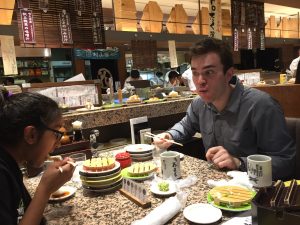
Japanese public transportation, in general, is amazing and unlike anything I’ve seen in the States. The first thing to note, as in the shinkansen example, is that every train, subway, or bus always arrives and departs on-time. This sense of order and form, represented in Japanese as 型 (kata) permeates multiple layers of Japanese society from the transit system to the timeliness of every meeting and appointment. Of course, this is very absent in most places in the US, especially in the two places I call home: laid-back California and relaxed Texas.
Moreover, it is the people that really make the difference in this system. There are several unwritten rules that people seem to follow on public transportation. For one, Japanese people on public transport almost never talk, and when they do they are barely audible. Our group of students is always the loudest on the train. Japanese people are always mindful of how much space they are occupying, whether they are sitting or standing. Because of this, I decided to buy surgical masks to wear because I was getting some dirty looks from Japanese people when I coughed on trains. All this point to 和 (wa), the sense of order the binds together Japanese society. For Japanese people, it is critical to act to promote the group interest, which contrasts with the rugged individualism I’m familiar with from back home.
However, one problem with the subways is that they can get extremely crowded, and you can often observe squeezing to the extreme to fit everyone on a single train. Even Japanese people look visibly uncomfortable when this happens. Evident here is the tension between Tokyo’s bulging population and the desire for harmony and order.
It’s interesting to see almost every Japanese person on a subway train either asleep or on their phone. I’ve even often seen people trying to sleep while standing up. I rarely see Japanese people chatting with each other. More broadly, I’ve noticed this throughout Japanese life in general. As we were told, chit-chat is a lot less common here, which is something I’ve come to appreciate. Though I’m a talkative person, I like taking moments to appreciate silence now and then.
Overview of Week Three of the Orientation Program in Tokyo
I definitely took a breather this week because the Mt. Fuji trip was tiring and I started getting feeling pretty sick. Of course, I still have several highlights to share. Though the biology section of his talk went over my head a little bit, I really enjoyed listening to Dr. Gert-Jan Bekker from Osaka University talk about his experiences being a long-term international researcher in Japan. His use of Japanese with Endo-san and Ogawa-san was impressive, especially considering that he came to Japan with very limited Japanese. He offered many useful tips, such as finding online language buddies, that I plan to use in the future to help me study both Japanese and Chinese.
My favorite cultural talk of this week was from Dr. Kunie Ishioka, leader of the optical characterization group at the National Institute for Materials Science (NIMS). She inspired me with her story of pursuing her dream of science in a country that so stiffly opposes women in academics and science. It was shocking to hear some of the statistics she quoted regarding women in higher education and science in Japan. Just a few decades ago, even if you were one of the few Japanese women to obtain a PhD in science, you could essentially be blocked out from getting an academic position. Academic positions were often solely based on connections, and the male-only club of academia would be hard pressed to offer a position to a woman. Her talk motivated me to stick close to my scientific goals and dreams, and persevere in spite of the many challenges that being a researcher brings.
I also enjoyed Dr. Don Futaba’s talk about being an original second-generation Japanese-American who moved to Japan after obtaining his doctorate. Hearing his experiences really resonated with me especially because we both grew up in the same area in California and we are both second-generation Asian-Americans who have to deal with the expectations that that gives rise to.
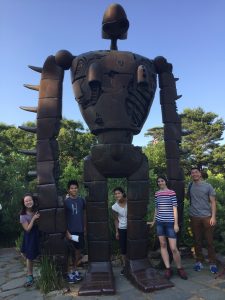
Since the start of this trip, I have been enjoying watching many popular anime films in a group, including Kimi no nawa (AMAZING MOVIE, by the way!), Koe no kotachi, and The Girl Who Traveled Through Time. It’s also impossible to miss the influence of anime and manga when walking around Japan, especially in areas like Harajuku and Akihabara. Because of this, I really enjoyed listening to Dr. Saeki of DŌshisha University discuss the evolution of the role of women in popular Japanese media. I know it’s difficult in Japan to be a female academic, let alone a female academic whose work centers upon condemning the Japanese patriarchy. Dr. Saeki’s work is extremely important and relevant — it helped me connect my observations about the gender gap in science to the role of women in culture and media.
For the basic science overview this week, it was nice to review with Professor Stanton some basic solid-state physics and solid-state electronic applications. I really learned a lot from his lecture on femtosecond spectroscopy techniques; he presented it in a simple manner that made it very intuitive to understand. Dr. Ishioka expanded on this by presenting how experimental work at NIMS in femtosecond spectroscopy for materials characterization, with a particular example being characterizing novel perovskite solar cell materials. Dr. Futaba gave an overview on the basics of CNTs and CNT synthesis.
Question of the Week
One thing I’ve been surprised to learn about in Japan is that most Masters students apply to jobs in industry and are not interested in a doctoral degree, as many industrial jobs want masters graduates, not doctoral graduates. Still, those students interested in a doctoral degree must get a Masters degree first. Do these masters students have a different role in the lab than the Masters students that just want to go to industry?
- Good question, and this is something you may be able to learn more about by talking with your lab mates in Kyoto and/or speaking with Prof. Kono or the other Japanese Fellows about. In the U.S., students who get a PhD also must get a Master’s first but it more common to directly enroll in the PhD program and then get your Master’s along the way. For example, you are admitted to the PhD program in Electrical Engineering and after you complete your coursework and pass the qualifying exam/course you can submit your Master’s thesis and then advance to PhD candidacy. Some U.S. students even walk through graduation twice, once when they receive their Master’s and again when they complete their PhD as they want to mark each of these milestones. This also means that, if for some reason, a PhD student realizes along the way that maybe completing a doctoral degree isn’t the right path for them they can stay as long as it takes to get their Master’s and then leave the program with a degree in hand.
- However, there are other science and engineering Master’s program in the U.S. that do not require research or a thesis. At Rice University, these are called Professional Master’s degrees. Non-research based science and engineering master’s degrees are often targeted at students who have worked in industry for a few years return to school to complete a Master’s degree (often with partial or full funding from their employer).
- In Japan, all Master’s students take coursework and do research. They usually stay at the same school they received their Bachelor’s degree from and typically also stay working in the same research lab that they began doing research in during their B4 (senior) year. In this way, they actually spend a total of 3 years working with the same group even though they only do research as a graduate student for two. One of the primary differences might be that at the end of their Master’s degrees, students who plan to go into industry will begin spending a lot of time on job hunting whereas students who plan to go on to complete their PhD may be able to stay more focused on research – until they near the end of their PhD at which point they may spend more of their time on job hunting either for positions in industry or academia.
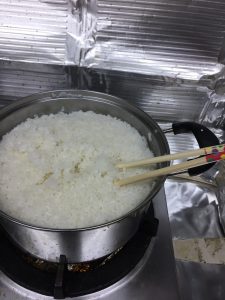
Research Project Update
Because it’s late, I’m going to save a detailed discussion of my project for next week’s report, but today was my first day in the lab and it was so exciting to discuss my project in detail with Miyauchi-sensei. My project involves optical measurements to probe the exciton relaxation dynamics in monolayer WSe2. After a warm initial welcome to the lab at our group meeting this morning, I met with Miyauchi-sensei for about an hour and a half, then got right to work. I hope in the next few weeks to learn how to use all the major equipment, and successfully fabricate a particular heterostructure that I will make optical measurements on. If I can accomplish this soon, I will have plenty of time to make some measurements. Today my mentor Zhang-san taught me how to mechanically exfoliate monolayer WSe2 using the Nobel-prize winning Scotch-tape method and confirm its thickness using Raman spectroscopy. After that, I was able to successfully exfoliate a monolayer on my own! I’ve begun tackling a long-list of exciting, albeit challenging, papers that will hopefully help me understand the basic physics behind exciton dynamics in these TMDC monolayer materials. Moreover, I could not be more ecstatic about the group that I joined — they welcomed me so warmly with open arms. More on that next week!
Week 04: First Week at Research Lab
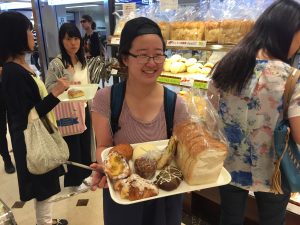
I am now a part of the Matsuda Lab! It’s officially been a week since I’ve started, and I’ve had a blast while working very hard. On the first day, I arrived just in time for the weekly group meeting, where I was introduced to the entire group. The style of the group meeting was much different from what I was used to in the US; every member reported to the professor, associate professor, and assistant professor with their research progress in the past week and what they planned to do in the coming week. In the US, it seems like group meetings last at least 2.5-3 hours, but the Matsuda group’s meetings are efficient and to-the-point, 1 hour long meetings. I really like this aspect of the group because it allows the entire group to be updated on others’ progress and encourages everyone to strive for incremental progress and set goals.
After this, I met with my PhD mentor, Zhang-san, and my associate professor, Miyauchi-sensei, to talk about my summer research project. He very clearly outlined his goals and expectations for me, and after about an hour and a half meeting with him, I got to work! These two mentors have been instrumental in getting me familiarized with the lab quickly. In fact, the entire lab has helped me many times with various equipment and procedures. I’ve quickly realized that I love being in a large lab group setting common at somewhere like Kyoto University but not at a smaller school like Rice. This is something I will continue to think about this summer and next year when I apply to grad school.
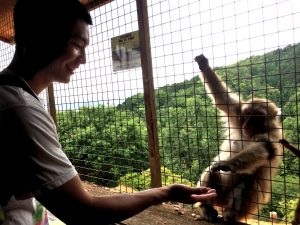
My assimilation into the lab has been super smooth because the research they do is similar to my lab at Rice, and English is the primary language of communication in our very international lab. Basic communication and science communication is usually easy; more conversational communication is a little difficult, but I can usually manage with a combination of broken Japanese, Chinese, English, and gestures.
My housing at the Mukaijima Gakusei Center is awesome! I bike to work with the used bike I bought nearby, and it’s very close to everything. Because I’m not in Kyoto city but a more suburban area called Mukaijima, my bike route to lab crosses many rice paddies and gorgeous mountain/river landscapes that could not contrast more with the city landscape of Tokyo.
After having spent a week in my new home, Kyoto, I am very thankful for the 3-week orientation we had in Tokyo. I use much more Japanese here than I did in Tokyo, because I live in a fairly rural area, so people outside the lab don’t really speak English. I definitely would feel more like an outsider and uncomfortable in this situation had we not spent time in Tokyo to discuss language and culture together. Additionally, I’ve never lived on my own before, so shopping and cooking for myself is definitely a new adventure! Already, I feel more confident in my ability to live independently. Time management is something I’ve always prided myself on, but I’ve been surprised with how much I’ve improved in this regard since coming here. I’m lucky that I have a lot of independence over my research project, so I decide when I come to lab. Usually I come at around 10 AM and stay until at least 11 PM – midnight. I’m definitely not slacking off, but I’m having so much fun with research and life in Kyoto!
Question of the Week
Probably the only complaint I have is that the Uji campus is very geographically separate (an hour by train) from the main Yoshida campus, where all the clubs, libraries, gyms, etc. are. Is there a reason besides space that so many Japanese universities are partitioned into several different campuses?
- Usually, one of the campuses is more of the undergraduate campus where students take classes and, therefore, this is the campus that undergraduate student life tends to center around. Other campuses may have a specific focus on an area of research and are where the graduate schools and research laboratories/institutes are typically located. Remember, undergraduates only do research in Japan as part of their B4 year so there isn’t such tight integration between graduate and undergraduate life as you see at places like Rice where undergraduates, even freshman, are working in research labs alongside graduate students. If you look at the university structure, you will also see that there are Graduate Schools of Engineering or a Graduate School of Science rather than one School of Engineering or School of Natural Sciences that encompasses both undergraduate and graduate education. Therefore, even within the structure of the university there is a split between undergraduate and graduate education.
- Also, as universities grew, especially to accommodate the baby boom following WWII and increased demand for higher education in the 70s and 80s, they didn’t have much physical space in their central, in-city locations to expand. Population densities can be very high in cities in Japan and land is very expensive. Since universities in Japan have, historically, been almost wholly funded by the government they would often be assigned/purchase land at discounted rates in more rural areas where they could develop new research facilities. This also gave an economic boost to the more outlying areas of the city, bringing jobs and increased demand for housing/services in the area. So, from a government policy initiative there were multiple benefits to expansion of university campuses to locations outside of the city center.
- You may also want to ask your host professor about this and if he, or the assistant or associate professors in his lab, teach or have much interaction with undergraduate students. You can read more about the history of Kyoto University, and your particular campus, to better understand its expansion.
Research Project Update
My research project deals with a particular 2D semiconducting transition metal dichalcogenide material, tungsten diselenide, WSe2. In the monolayer limit, WSe2, like other well-known 2D TMDCs, is a direct bandgap semiconductor, which means it has great potential for use in optoelectronics. Monolayer WSe2, like other semiconducting TMDCs, also has been discussed often in the emerging field of valleytronics. In 1L-WSe2, broken inversion inversion symmetry leads to spin-orbit coupling and broken valence band spin degeneracy at its two main “valleys” in reciprocal space. This leads to the ability to selectively populate either of the two valleys using the circular polarization of incident light. In 1L-WSe2, excitons (bound electron-hole pairs) dominate the optical activity, and it is these excitons that can populate the valleys. Current researchers can easily measure valley polarizations in 1L-TMDCs at close to 100% using polarization-resolved photoluminescence spectroscopy. However, much less is known about the basic physics behind valley polarization and the dynamics that happen between exciton excitation and complete loss of valley polarization. Recently, my lab has done a lot of theoretical work to supplemental their experimental studies to probe the physical mechanisms behind valley relaxation, the process of losing valley polarization, in 1L-TMDCs.
My research project this summer is to synthesize a special 2D material heterostructure (that includes WSe2) and characterize it using time- and polarization- resolved photoluminescence spectroscopy. In other words, I need to synthesize a very special heterostructure, or sandwich, of 2D materials that I hope will lead to a longer valley polarization lifetime than has currently been reported in the literature, which is a hope based on work my lab has done in developing a unified theory of exciton relaxation dynamics in these materials.
On Saturday, I synthesized the heterostructure in question, and will learn how to measure it in cryogenic conditions on Wednesday, but based on some room temperature analysis I made today, I’m guessing that the sample I created wasn’t of high enough quality. Because of this, I hope to spend the next week and a half or so perfecting my sample synthesis. After that, I will hopefully have multiple high-quality samples that I can characterize under cryogenic conditions. The measurements I plan to run are time- and polarization-resolved photoluminescence spectroscopy.
It’s only been a week, and I feel I’ve learned so much about being in a lab, especially with the amazing amount of equipment they have here. Sometimes the equipment is pretty challenging to use because the software is all in Japanese! Thankfully, I have amazing lab mates who never tire of helping me often. So far, I’ve learned how to use the Raman spectrometer, room temperature photoluminescence spectrometer, 2D material mechanical deposition system, and atomic force microscope. I haven’t spent any time in the optics lab yet, but hopefully if I can create some high-quality samples, I will learn a lot about lasers and optics, which I have basically zero experience in. In terms of chemistry, I’ve only done basic 2D material sample preparation by mechanical exfoliation (the “Scotch tape” method that won the Nobel Prize!), which is definitely an art and an exercise in patience. I’m definitely a little bit of a clumsy and sloppy chemist, so this is definitely something I hope to improve on this summer!
Week 05: Critical Incident Analysis – Life in Japan
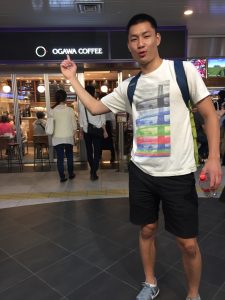
Back home in America, I feel that I can usually make friends quite smoothly, especially if I find out that they have similar interests as me and we share things in common. This week, my critical incident analysis of a situation with differing cultural perspectives happened while trying to make friends with a student studying at a nearby Kyoto university. This was my first real experience making a Japanese friend outside my lab since coming to Kyoto.
I’m super lucky that my student residence center, the Mukaijima Gakusei Center, often hosts events for international students. Last Friday, they hosted their weekly Japanese language class, where college students from nearby Kyoto Bunkyo University cme and help us with Japanese. My sensei was a college freshmen, who was very kind and connected with me very easily. Because during the lesson, he told me that he loved McDonalds, I invited him to go to McDonalds with me for dinner. After all, I had not made any Japanese friends outside of lab yet, having been in Kyoto for less than two weeks. We had an awesome time at dinner, and it was easy to relate with him, as we are of similar ages and both university students.
However, I ran into sometime significant cultural difficulties in navigating a situation that is so commonplace back home. First of all, there was definitely a language barrier between us, and I tended to keep nodding my head and saying “hai!” when he would ask me a rapid question in Japanese. I didn’t want to keep interrupting him and asking him to repeat or slow down or try the question in English. This almost felt like when you’re in class and keeping nodding your head to a lecture, even when you only understand half of it, and by the end you feel really confused. In attempting to hide my foreignness, I made communication much more difficult than it would’ve been if I had asked to slow things down.

I’ve learned from the pre-orientation speakers and discussion sections that socializing in Japan can be much different than in the United States. Many peoples show two totally different sides of themselves when, for example, they’re with friends at work or with friends at a restaurant. In Japan, people hardly ever invite you to their home unless you’re much older, which probably has something to do with small room sizes. I was cognizant of all this at the time. For me, this made me wonder whether I could use the same college student phrases such as “Hey, we should definitely hang out some time. Wanna get dinner tomorrow?” that I use almost every day in America. For one, I’m not even sure if “hang out” translates into any other language besides teenage English? Also, and this is especially true with women, I’m usually not sure if making a statement like that with a Japanese woman will make me appear like I’m asking them out on a date. In America, where I’ve grown up my entire life, it’s easy for me to understand the nuances of “Hey, we should get dinner tomorrow,” but in Japanese, I often feel that I have no idea what the connotations of what I’m asking are.
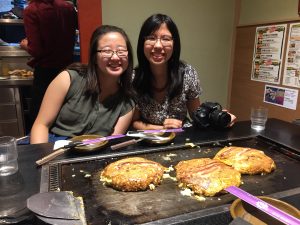
Regardless, I think that I successfully made a pretty awesome Japanese friend on Thursday and I hope I will see him again soon. This was a valuable experience for me to reflect upon all the cultural assumptions and understandings submerged in the metaphorical “cultural iceberg” that I would never have thought about being just in America. I know that the only way to make myself more comfortable in these situations is to have more practice. Situations like these definitely put me outside my comfort zone a little: in America, I usually find it very easy to make friends as an extroverted person, but in Japan, I am constantly thinking about each word I say. But such experiences are perfect examples of why cross cultural-communication can be both difficult and rewarding, in terms of personal growth and the ability to form meaningful relationships with people.
Research Project Update
I made a lot of great strides with my research this week and also learned a lot about working in an experimental laser spectroscopy setup.
I continued my construction of 2D material heterostuctures, and made a sample that I hope to test next week at 10 K that looks to be very promising based on the room temperature photoluminescence spectrum that I measured. I’m learning quickly that having a large lab group can be awesome for all the knowledge and resources that I’ve praised in past reports, but it can also be frustrating when you have multiple people wanting to use the same laser setup. This is why I made my sample last week but can only test it at the soonest in another week from now.
I tested the first structure that I built during my first week in the lab at 10 K, doing basic polarization-resolved photoluminescence spectroscopy as a function of excitation power to observe the effect of exciton density (excitation power) and how this effects linewidth and other important characteristics of the excitonic spectra. Unfortunately, my sample looked to have a good amount of surface defects, as the defects and other “localized states” kept saturating the spectrometer. Regardless, Miyauchi-sensei told me that my experiment had very good results and helped them understand how their theoretical work plays out on the experimental side. Also, it gave me a lot of experience navigating our complicated low-temperature, polarization-resolved laser setup, which has a lot of optical components. While I am still in the mode of watching my mentor handle the complicated laser alignment, I am gaining much independence and ran the actual experiment by myself. After this, I conducted a lot of analysis on this spectral data in MATLAB and presented my results in group meeting today.
Besides this, I have been reading many papers that are trying to build similar 2D material heterostructures as we are, and have finally suggested to my lab that we update our setup for creating heterostructures. I think it would greatly benefit our lab if we followed the lead of these papers to use an additional polymer film (which I successfully synthesized today by simply dissolving in chloroform) and the ability to heat our heterostructure stage to a specified temperature. This will allow our lab, hopefully, to build complicated structures with more precision and less contamination. My lab seems very open to the idea, and I hope to start building this setup soon. The only frustrating thing, of course, is that ordering many different parts and chemicals, of course, takes time, and not everything can be shipped from Japan.
Other than that, I hope to continue making samples and test some of them next week at low temperature! Also, I still only know the basics of how to manage our time-resolved ultrafast spectroscopy setup, and I hope to run these more sophisticated measurements next week also if my samples look any good.
Week 06: Preparation for Mid-Program Meeting
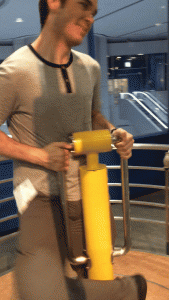
It’s so hard to believe that I’ve been living in Japan for just about six weeks now. I’m proud of how much I’ve grown, both as a scientist and as a person in such a short time. For me, my biggest personal accomplishment outside of research has been the development of a growing sense of independence and comfort in an unfamiliar environment. All my life, I’ve grown up in environments that are often described as “bubbles” — my hometown, Palo Alto, CA and my university, Rice University. But now, I’ve been living for the most amount of time I’ve spent away from either of these places. Feeling a little less like a tourist and more like a resident is an accomplishment and a victory for each day. For me, especially, I’ve come a long way in being able to navigate my area of Mukaijima, which is a very suburban part of Kyoto where there are few tourists and consequently, a lot less English speakers around.
Navigating living on my own for the first time while also working hard in lab has been challenging, to say the least. When I first got here, I procrastinated on getting grocery and living supplies, not realizing that shops here close much earlier than in Tokyo city — my first shower without soap or a towel was an interesting experience. On a rush to work, I’d often leave in a rush after making breakfast, thinking that I could wash dishes when I got back. I soon learned that if I didn’t wash my dishes, I’d be greeted with bugs who love the free food. Sometimes, I would get too eager at the grocery store, forgetting that fresh fruit and vegetables will go bad if I spend too many late nights at the lab and don’t use them.
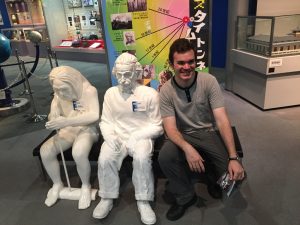
Each one of these silly blunders, and there have been many more, has made me more confident in my ability to live independently. Being transplanted to a whole new country with Nakatani friends in the very near vicinity has pushed me in the best of ways. I feel that I’ve become a more patient person — when living on your own in an unfamiliar place, mistakes will often happen and not everything will go as planned. I’ve been proud of how much exploration I’ve done while here. For me, this doesn’t mean I’ve seen all the 200+ temples in Kyoto, but I’ve asked a random Japanese student to get dinner when I met him on a basketball court (thank you AJALT for teaching us how to invite people to do something!!); I’ve met a friend randomly while playing piano in my dorm; I never tire of exploring new areas around where I live with my handy bike.
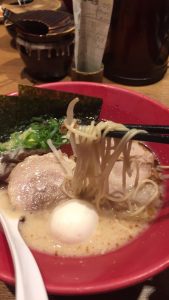
The great majority of my time, so far, has been devoted to thinking about my research project and spending time fabricating samples and conducting optical measurements. Research has brought its own whole set of setbacks and frustrations, but I’m making decent progress towards my goal. For now, I’m looking forward to working hard and then relaxing a little bit once I get to see the other fellows for the Mid-Program Meeting!
Research Project Update
This week, I conducted both photoluminescence spectroscopy and time-resolved photoluminescence decay measurements at low temperature with two heterostructure samples I prepared recently. Unfortunately, the sample quality was, again, not so good, and the photoluminescence spectra had undesirable characteristics, including very broad exciton photoluminescence peaks. I did, however, make some more measurements on pure monolayer WSe2 in this low temperature setting, but for some reason the time-resolved measurements had some strange abnormalities when I conducted analysis yesterday, so we have to spend some more time aligning the optical components carefully next time we measure.
Seeing two more samples that I made fail was disappointing, but I’m hopeful that I will get it to work soon with a bit more effort. I also hope to make samples on a few more different substrates (namely, quartz) to see if that has any positive effect. In parallel, I’m still investigating whether modifying our heterostructure setup to allow for heating during 2D material transfer will improve the process.
Next week, I hope to make more measurements at low temperature and report back with successful results!
Week 07: Overview of Mid-Program Meeting & Research Host Lab Visit
After several weeks of pretty hard work in the lab, I was happy to meet up with all the Nakatani students (US and Japanese) again at the Mid-Program Meeting in Kyoto city. Talking to the Japanese fellows again, in particular, as they gear up for their own research experiences in America, was particularly rewarding. With some Japanese research experience under our belt, we were able to discuss with the Japanese fellows a lot. It felt like a very mutually beneficial conversation that will help both sets of Nakatani fellows think about their respective research experiences in the context of differing cultures.
In addition, it was also great to take some time away from the lab to reflect on our experiences together so far. It’s so interesting how different some of our various labs operate, whether in terms of social gatherings, language used in the lab, lab members’ schedules. One thing in particular that I was grateful for is that I have lunch (pretty much) every day with my three senseis: Professor Matsuda, Associate Professor Miyauchi, and Assistant Professor Shinokita.
This seemed very unusual with respect to the other fellows, who mostly just eat with other students. This is one of the most enjoyable aspects of being in my lab, and I love being able to get to know my sensei in a casual setting. Reflecting on my research so far during the Mid-Program Meeting was extremely rewarding. Through discussing with other students, Professor Kono, Sarah-san, and others, I began to realize just how much I’ve learned so far this summer, not just about experimental physics. The most important thing I’ve learned so far is what it feels like to be immersed in research 24/7 in a laboratory that has never had an undergraduate student before. This experience contrasts a lot with the research I’ve done previously: at school, I will spend on average 2 hours a day on research—if I spent more, I wouldn’t be able to have any fun or do well in classes. Here, I’ve learned to adopt a totally new mindset towards science and research. Because research will never reward you linearly with effort or time, the first few weeks were a little rough for me. I was working extremely hard, all day with little sleep, trying to get the “good results” as quickly as possible. And sometimes I would get them, but most of the time I wouldn’t, and I would be extremely disappointed in myself.
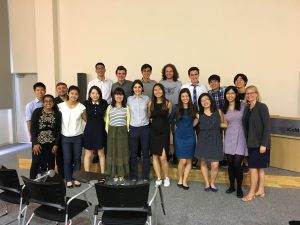
Now I’m starting to learn that this results-oriented mindset is actually very harmful. In school, one can study hard, and as a result, learn a lot about science and do well on assessments. In research, hard work is also required, but results-driven success is never guaranteed. I actually find myself a lot happier and content with myself now that I’ve adopted a more process-driven mindset. I embrace “failure” more readily and my main goal each day is to have learned a lot, whether about experimental technique or theory. I’m pacing myself, taking time to recharge and reflect each day, and it’s been really rewarding to feel myself grow as a scientist and a person.
Mid-Program Meeting Research Introduction Presentation
As part of the Mid-Program Meeting, on Monday, July 3 our 12 U.S. Fellows gave a presentation at Kyoto University introducing their research project and future plans. Alex presented on the research he is doing in the Institute of Advanced Energy, Matsuda Laboratory at the University of Kyoto entitled “Probing exciton valley pseudospin relaxation in monolayer WSe2“. Click here to download a PDF of his presentation.
Mid-Program Cultural Experiences
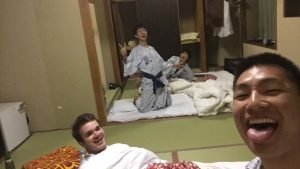
The Mid-Program Meeting included some incredible cultural experiences that I will remember for the rest of my life. A big thank you to the Nakatani Foundation, and especially Horikawa-san, for all of this! Horikawa-san’s wife provided us all with yukata, casual Japanese summer kimono. Dressed in yukata, we participated in a traditional Japanese tea ceremony with presentation of powdered matcha tea. I was in awe of all the meticulous details of the ceremony, from the handselected calligraphy on the wall, to the tea master’s careful cleaning of the teapot and bowl, to the calculated motions we were required to make with the teacups.
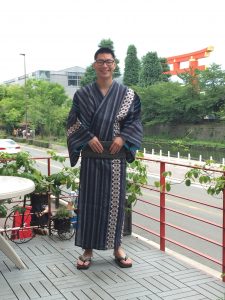
wear to the tea ceremony and around Kyoto. Thank you so much for this!! ~ Alex Hwang
Another fantastic highlight was getting a tour of the important Kamigamo Shrine. Our tour guide was a Shinto kannushi (person responsible for leading a Shinto shrine), who is a friend of Horikawa-san from the Nakatani Foundation. He gave us the incredible opportunity for us to see many things normal tourists wouldn’t be able to see, including the residence of the divine spirit and close-up view of the meticulous reconstruction process that occurs for all Japanese shrines. Getting this insider’s view and perspective on Shintoism and Japan was probably my favorite experience in Japan so far.
Reflections on the Host Lab Visit
Last week, Kono-sensei, Sarah-san, and Ogawa-san visited my laboratory. Because this happened to coincide with the day I was running a long laser spectroscopy experiment at low temperature, I was extremely stressed out before they came. Low temperature measurements means having to keep a careful eye on many things, including the liquid helium dewar (which would basically kill me if it exploded), sample temperature, and cryostat pressure, not to mention that I was trying to finish my measurements quickly to be courteous to a PhD student who also wanted to use the setup that day. With all of this, I had to make sure my laser setup was perfectly aligned so my measurements wouldn’t be ruined. Having a million things to think about on this day in addition to the lab visit gave me a tiny glimpse of what being a busy researcher/professor may be like in the future, and it was very good practice for me to keep calm, stay patient, and focus on one thing at a time. When Kono-sensei, et al. finally got here, I realized I had nothing to be stressed about. They simply wanted to see my lab and have me explain what I use on a daily basis. Afterwards, I felt proud of myself, because after this I really realized how much I’ve learned in terms of experimental science. I was able to explain not only the simple characterization equipment I use (AFM, Raman, PL), but also more complicated optical components inside our laser spectroscopy setup. It was a nice moment to appreciate how much being a member of the Matusda lab has taught me about experimental optics.
Research Project Update
This week I made two major breakthroughs! First, by changing the type of TMDC material I was using in my heterostructure, I was able to observe room temperature photoluminescence measurements that actually looked really good, much better than anything I had achieved with the previous TMDC material. I have already tried to conduct some more analysis on this sample, including room-temperature exciton diffusion length measurements and exciton lifetime measurements. If the results look good, my mentor will use these results in an upcoming Fullerenes and Nanotubes Research Society conference. I’m not sure if they will come out so well, though, because we were having a little bit of trouble with the time-correlated single photon counting (TCSPC) setup. It’s kind of a frustrating setup, because it will sometimes behave very strangely, producing very unstable results.
In addition, I finished my analysis of a sample I conducted low-temperature measurements on a long time ago. This analysis took so much time because I had to do a lot of curve-fitting, because the exciton peak on this sample was convolved with a lot of peaks from lower-energy localized states, so the deconvolution took some time. These results looked really good, so I showed them to Miyauchi-sensei, who said that they might be added to a recently submitted manuscript.
Our low-temperature setup will be very busy over the next couple of weeks, with Zhang-san, Shimasaki-san, and myself all sharing it over the next two weeks. After that, a professor from Nagoya University will be using our setup for a week, so I’ll be working hard to explore this sample further in my limited time these next few weeks.
Week 08: Research in Japan vs. Research in the U.S.
Before arriving in Japan, I expected an English-speaking research lab in Japan to operate basically the same as my home lab at Rice. After having been in my Japanese lab for nearly a month-and-a-half now, I can say that this is essentially true, but also that there are many important differences about being in a lab here.
To start, in Japan, there is a much more noticeable hierarchy within each lab. For example, my lab has not only graduate students and post docs, but support research staff, a secretary (I am under the impression that only the large labs in the US will have a designated secretary, whereas here, all labs seem to have a secretary), an assistant professor, an associate professor, and a full professor. In addition, there is a clear hierarchy within graduate students here, as masters students are an entirely separate category from doctoral students. Just in terms of language, there are a lot of intricacies that this hierarchy elicits: for our full professor, it’s totally fine for him to call anyone in the lab, even an assistant professor, -kun or -san, whereas for me, at the very bottom of the totem pole, I always must use polite speech when talking to others in the lab. In terms of research, this also makes for a more complicated web of collaboration, expertise, and “territory” that I don’t think is experienced nearly as much in the US. For instance, in the US, paper authorship within a lab seems to usually be pretty straightforward: the graduate student or post doc is usually first author while the PI is usually last author. In Japan, though, I can imagine it can get much more tricky when you have many different levels of lab members contributing to a paper.
Although I’m not too familiar with the details of what kinds of publications are expected for PhD candidates in the US (it seems very dependent on the lab), it seems that these expectations are a lot different in Japan. For instance, in my lab, masters students are not expected to publish, while PhD students are expected to publish three first-author papers in just three years. I imagine that PhD students here probably feel more time pressure to publish and obtain a lot of good experimental results, while not necessarily shooting for the most prestigious journals. (Please correct me if I’m wrong about this! I’m not a graduate student, of course, so I could just be saying nonsense.) To me, it feels that graduate students in the US have more freedom over the direction of their research. It feels like a tradeoff exists between organization (e.g. more regimented Japanese structure, with many levels above PhD student) and freedom (e.g. more responsibility in US labs, but potential to take 7+ years to earn a PhD).
Our lab’s recent monthly meeting (long, ~10 hour meetings where everybody presents their research) was definitely an interesting experience and helpful in comparing my experience here with the US. The last people to present were our professors, and our full professor actually only had a single Powerpoint slide. He basically wanted all of us to engage more with our research, and especially with each others’ projects. He wanted us to ask more questions, discuss more about the fundamental physics behind others’ assertions. He even said that it is not natural for Japanese people and researchers to be outspoken like this, but that he wanted his lab to be much more vocal. This was definitely energizing and inspiring for me, and I could feel the change in my fellow lab members after this point. It seems like it may be easier for lab members in Japan to feel stuck inside a box with many defined roles in the lab.
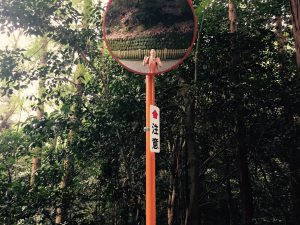
went on a hike nearby. I’ve learned that the best time to visit temples is when it’s raining,
because even the most famous ones can be almost empty! ~ Alex Hwang
Ultimately, I truly feel that there are many valuable things I have learned about being in a Japanese lab that I can bring back with me to the US. I have learned much about working productively and efficiently. Frankly, I have learned how to work hard, harder than I ever have before. I’ve learned how valuable it can be to have a diverse lab with members of extremely varied scientific and cultural backgrounds. Having a strong hierarchical structure can be extremely beneficial in organizing many research projects and having multiple people oversee more inexperienced students like myself.
Research Project Update
This week, I prepared several more new heterostructure samples to measure later today at low temperature. I’m excited to see if they actually turn out to have good results! They looked promising at room temperature so I hope I get a little lucky at low temperature.
This week I have also been digging deep into the theory behind my project a little more intensely. I realized at the Mid-Program Meeting that I need to have a much better theoretical understanding of my project because I want to come out of the summer not just with the ability to fabricate 2D material heterostructures and manage a laser setup but also understand what’s going on on the theoretical side. Some things I’ve been studying are:
- Coulombic screening effect and solving the screened Poisson equation with Thomas-Fermi assumptions.
- Theoretical work on valley relaxation/depolarization in TMDC materials.
- Quantum mechanical exchange interactions, especially in semiconductors.
- Different types of experiments similar to mine and how they work: pump-probe, four-wave mixing, etc.
- Different types of spin relaxation theory.
It’s definitely been challenging for me to pour through these topics, but I’m glad I have plenty of time during the summer to try to understand these things at a deeper level.
Return to Top
Week 09: Reflections on Japanese Language Learning
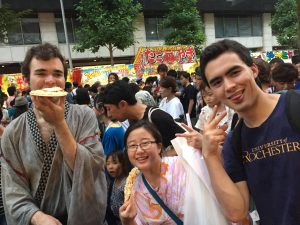
I think I’ve been really lucky with my lab placement not only for getting a fascinating project to work on but also because of my fellow lab members. English is the primary mode of communication in the lab, but half my lab is native Japanese and the other half is native Chinese. This is almost perfect for me, because I, of course, applied to this program because I wanted to learn more Japanese, but it’s also really nice to try to communicate in Chinese too because my Chinese is pretty bad from not speaking at home. While speaking two more languages than I’m used to at home can cause a little bit of a headache sometime, it’s obvious to me that attempting to speak someone’s native language, even if you sound terrible, will get you closer to that person. I’ve always been a little wary of practicing language with native speakers, because I honestly had bad experiences growing up where I’d try to speak Chinese (an incredibly tonal language) and be mocked. But now I feel more much comfortable jumping out there and just doing my best, even if I know it doesn’t sound perfect. Because of this, both my Japanese and Chinese have definitely improved since being here. I actually recently called my grandmother and spent several minutes speaking to her in both Chinese and Japanese, which I think made her really happy. Regarding Japanese, I’m surprised how much I use “casual form” with my Japanese labmates, who may be much older than me, even up to ten years older. I asked one of them about this once, and his only response is, “we’re friends, of course!”, which made me smile.
I’m proud of the way I’ve been able to gain confidence in my language abilities this summer and now realize how amazing language can serve as a bridge to connect people across cultures. I’m excited for the last few weeks here and hope this summer is just the beginning of a lot more learning about Japanese language and culture.
Research Project Update
This past week, I continued making heterostructure samples and finally got a really nice one! I conducted some low temperature optical measurements on the sample and will start analyzing the data tomorrow. The new heterostructure I made were of MoS2, and these showed very interesting results compared to my work with WSe2, another type of transition metal dichalcogenide. I wasn’t able to quite reach the extremely narrow linewidths reported in a recent publication, so I need to do some more brainstorming in lab on what I could do to make higher quality samples. Also, the data I collected should be very helpful for my laboratory as I was able to see valley polarization in an experimental condition that my lab had previously not been able to do before, so that makes me happy!
Week 10: Interview with Japanese Researcher
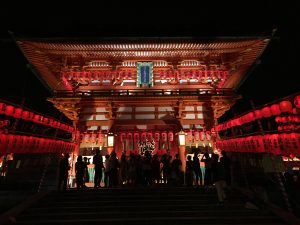
For this week’s cultural reflection, I decided to interview Shinokita-sensei, an assistant professor at the Matsuda laboratory. Throughout this summer, Shinokita-sensei has often been my late-night buddy in the lab. I was interested to connect with him more about his several experiences in international research, and hear about his plans as an up-and-coming young scientist.
Shinokita-sensei originally grew up in Nara, then attended Kyoto University for his bachelor’s degree in physics. He stayed in Kyoto University for his masters and doctoral degree with the Tanaka solid-state physics group. After that, he was a postdoctoral fellow first in the Netherlands, then in Germany, using ultrafast spectroscopy to probe III-V semiconductor materials.
I first asked Shinokita-sensei about how he decided to embark on this long track to Japanese academia that so many Japanese people seem to leave in favor of industry. He seemed a little confused when I asked this question. For him, it was a simple choice: he loved studying quantum physics and statistical mechanics, so he kept pursuing school. “But didn’t you ever think about leaving academia for a position at a Japanese industrial lab or company?” I asked. Actually, he said, he’s never experienced life in an industrial lab and has no intention of trying, so it’s impossible for him to compare. Shinokita-sensei is a calm, patient scholar who has followed and is following a simple path: follow what interests me. I could tell he seemed confused when I asked him so many questions about “why didn’t you do this?” or “why didn’t you consider doing this?”. He simply follows his interests, and for him, he has been extremely content as an academic. I feel like this is in contrast to the way most Americans think. In America, the “land of freedom” and choice, people are always considering other options, never seeming to be content with where they are.
Next, I was wondering what Shinokita-sensei thought about the diverse set of labs he’s been a part of. The first thing he said is that he thinks it’s extremely valuable for young researchers to have international research experiences. He talked about learning a lot from all the different labs he’s been a part of. In addition, when Japanese researchers stay at home, he said, it’s easy for them to get too comfortable staying in the same lab for many years, and as a result their work gets lower quality. His words definitely resounded with me as I’m wrapping up my research experience here in Kyoto. As a visitor from a whole new country, I’ve come into the Matsuda laboratory with fresh eyes, always asking “why this?” or “why that?” I think it’s been a really powerful experience for me to be thrust into a whole new environment and thrive.
As I was ending my conversation with Shinokita-sensei, I was happy from how much I had learned about all his experiences (which are too lengthy to describe here). The only thing was, I really wanted him to brag a little. For such an accomplished scientist, during this whole interview, he almost never talked about himself. He would deflect my questions about his personal accomplishments and achievements. His answers were simple and straightforward, not the grand, sweeping statements I’ve made countless times in my weekly reports when talking about myself. My final question was, “if you could sit here and give advice to the 20-year-old [I’m 20 years old] Shinokita-sensei, what would you say?” He had to think about that one for a while, but finally he said, “work harder. Study more physics.” Shinokita-sensei is one of the hardest workers I’ve ever met in my life. No matter how late I stay at night, Shinokita-sensei usually always stays after me, and he always arrives earlier than me in the morning. And though he says he would exhort his younger self to study more physics, I’m always amazed at the depth of his physical knowledge. His final statement to me was a powerful and humbling one. I feel that I have learned so much from Japanese scientists like Shinokita-sensei. He has a relentless determination to explore science and overcome research difficulties. Yet through all his hard-earned successes and achievements, he is quiet, humble, and still hungry for more.
Research Project Update
This week, I continued analyzing the large amount of spectral data I collected for my heterostructure sample from last week. I also have been doing a bit more analysis on low temperature data from a 1L-WSe2 sample from last month, which has turned out really well and will be the main result I showcase on my poster. I am also working on my poster and presentation for our lab group’s monthly progress meeting next week.
Week 11: Critical Incident Analysis – In the Lab
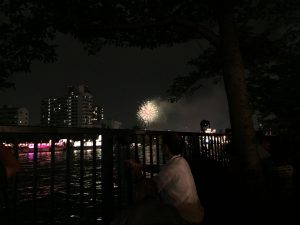
This past week has been super busy, analyzing a lot of data from a MoS2 heterostructure I made, making my poster, and preparing my final presentation for the Matsuda lab during our monthly meeting. Also, we had a really enjoyable farewell party for me in an incredible okonomiyaki/yakisoba restaurant. Before I leave, I hope to make sure my documented data is ready to pass off to Miyauchi-sensei for possible use in a paper, and do one last set of low-temperature photoluminescence decay measurements of my sample.
Week 12: Final Week at Research Lab
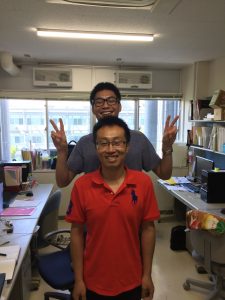
My final week in Japan was a tremendous way to cap off a phenomenal experience this summer in Kyoto. On Monday, my lab had a farewell party for me at an incredible okonomiyaki restaurant in central Kyoto. This was the only outing I had gone on with my entire lab, and it was really enjoyable. I saw many of my lab members open up and my professors said many kind words to me.
On Monday and Tuesday, our lab had our marathon monthly meeting. I presented on my research and felt extremely proud of all that I had learned and accomplished this summer. I was happy that I could not only explain my results but also answer questions about the fundamentals behind my research, because I spent a lot of energy trying to make sure I understood the basic physics behind my project. I also included a slide at the end of my presentation thanking each of the people in my lab for a different thing that they’ve helped/done for me this summer. It was difficult to fit this all onto one slide even with tiny font, and I think my lab really liked it. I really do have so much gratitude and appreciation for the kindness they showed me as a short-term guest in their lab.
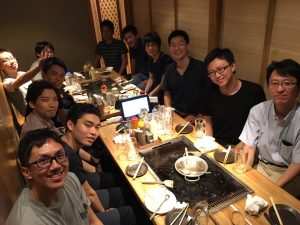
Because of the farewell party and monthly meeting (and squeezing another experiment at low temperature), this final week passed by in a flash. It felt so strange to have many emotional “good-byes” to my labmates when I felt like I had just arrived. After I made my final departure from my lab, I was bursting with gratitude and happiness. Every little act of kindness that my lab members showed to me, every late night that my associate professor would stay to help me with the spectroscopy setup, and every Japanese-to-English translation members of my lab would help me with—I started to think back on all of these moments. In addition, I felt an enormous sense of satisfaction with what I accomplished this summer. For the first time, I felt like I was truly dedicating myself to something, and that I was working with passion. I spent many hours in my lab, and felt like I had learned so much by fully immersing myself in this research experience. After leaving the Matsuda lab, I truly felt like I had been part of a mutually-beneficial partnership that exemplified how fruitful cross-cultural research collaborations can be. I feel like I have made not only life-long research partners but also have been able to have genuine Japanese experiences with Japanese people I can call my friends. I’m lucky that goodbyes aren’t too bad in today’s society—Miyauchi-sensei told me that we have to Skype about my data soon after I return to Rice!
As you can see, I was ecstatic about how my research internship turned out. Working in a Japanese laboratory that has never had an undergraduate, I was surprised at my quick adjustment to more research than I’ve ever done before. From my first day in Kyoto, Miyauchi-sensei told me that I would not be doing some training project, that I would be doing real research. And, indeed, I think I got a very realistic sense of research this summer. While I experienced several highs and was lucky to get some real, publishable results, I, more often than not, experienced frustrations and difficulties. But, following the example of my supremely resilient Japanese labmates, I quickly learned to appreciate these frustrations as learning experiences and inherent in science. I became more independent in my research habits, learning to structure my days with a balance of experiments, background reading, theory, documentation, and rest/relaxation. I became able to manage my own experimental setup, problem-solve, and think like a scientist. My ability to communicate scientifically improved leaps and bounds. Most of all, I was humbled by my research experience: the members of my lab are so motivated about and dedicated to science. They are curious, resilient, and hard-working. I hope to be like them someday.
Of course, my growth as a researcher is not the only rewarding thing I’ve experienced this summer. I feel that I have grown in so many ways culturally and personally in many aspects that I would not have expected a few months ago. Living in Japan on my own, in an area with not that many foreigners, was a truly eye-opening experience. It’s impossible for me to fully describe how this experience changed me as a human being, but I’ll try to provide some of the main points.
Living in Japan helped me become much more self-aware of my position in groups and society. Now, I feel that I am more cognizant of how my actions affect other people. This is true in one-on-one conversations, where I feel more empathy and ability to relate to others. It’s also true on a much larger scale: I am more conscious about every little item I put into the trash, for example. The group-centered mindset of Japan is one of the strongest differences I’ve noticed between Japan and the U.S., and it was extremely interesting to begin to internalize this for myself.
At the same time, living in Japan by myself has made me more mature, confident, and patient. I was successfully able to navigate a very unfamiliar place, and doing so made me grow up quickly. On your own, things often don’t go the way you expect, and patience is a vital quality needed to be able to adapt in these situations. Being by myself for much longer periods than I’m used to allowed me to spend a lot of time in reflection and introspection.
Japan has inspired me to have a greater appreciation and gratitude for natural beauty and culture. Though Japanese people are not particularly religious, they definitely have a deep appreciation and respect for their culture. The mixture of old and new is so interesting and unique in Japan, and I was lucky to see this in action many times. For example, one of my favorite activities was attending festivals, such as Gion Matsuri in Kyoto and Tenjin Matsuri in Osaka. The collective energy of these gatherings is so unlike anything I’ve experienced in the states, and has inspired me to be more grateful for my own heritage and culture. I listen to more Asian (Chinese and Japanese) music now, and I am being more active as an Asian-American in thinking about cultural and social justice topics that relate to my community.
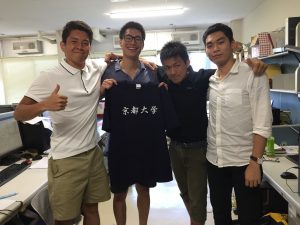
These are just a few of the things I have learned, culturally, personally, and academically, from my experience in Japan. It’s been a wild ride, and I can easily say that this has been the most impactful summer of my life. I’ll miss the beautiful convenience of everything in Japan: the public transportation and the convenience stores, most of all. I’ll miss the festivals, the politeness, and the deep appreciation of friendship. I’ll miss my quiet bike rides next to rice paddies, a gorgeous river, and picturesque mountains on the way to my lab. I’ll miss the kindness of my mentor, Wenjin Zhang, my professors, Yuhei Miyauchi and Kazunari Matsuda, and the rest of the members of my lab. Overall, I feel a powerful sense of gratitude and humility about this whole experience. I want to continue to push myself beyond my comfort zone, make discoveries about myself and my values, and make meaningful connections across cultural bounds.
Final Research Project Overview
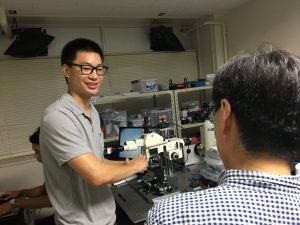
Project: “Exciton linewidth effect on valley relaxation in 2D TMDCs” (PDF)
Researchers: Alexander Hwang, Wenjin Zhang, Kazunari Matsuda, and Yuhei Miyauchi
Host: Prof. Kazunari Matsuda, Institute of Advanced Energy, Kyoto University, Kyoto, Japan
Introduction: My research this summer focused on valley relaxation in 2D transition metal dichalcogenides (TMDCs). 2D TMDCs can store binary information in their band structure using circularly polarized light. This process, valley relaxation, occurs quickly (~ps) and it is an important, ongoing research topic to pinpoint why it disappears so fast. My lab has done a significant amount of work developing a comprehensive theory of screened, electron-hole-exchange-interaction-mediated valley depolarization in these materials. They have produced experimental results that verify this theory in the context of screening and the way Coulomb screening evolves with different temperatures and carrier densities. My project was to investigate how linewidth (effectively, the inverse of exciton momentum relaxation time) affects valley relaxation in these materials.
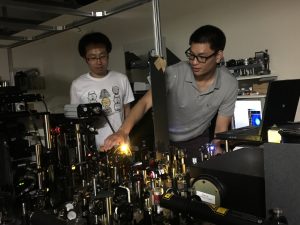
Approach: The most important techniques I utilized was steady-state photoluminescence spectroscopy. This involves exciting excitons in 2D TMDCs of a particular valley, then checking how that valley information is outputted as photoluminescence using a spectrometer. I also used time-correlated single photon counting on the same setup to track the radiative decay of excitons in these materials.
I used mechanical exfoliation to create both simple WSe2 samples on Si and more complicated encapsulated hexagonal boron nitride heterostructures with MoS2.
The main theoretical backbone to this project was developed by Satoru Konabe of Tokyo University of Science (Appl. Phys. Lett., 2016), Yuhei Miyauchi, and Kazunari Matsuda (Submitted, 2017), both of Kyoto University.
Results: I found that linewidth was inversely related to steady-state valley polarization in both 1L-WSe2 and hBN-encapsulated MoS2 (encapsulation significantly narrows the exciton linewidth, which makes it far easier to track over a range of excitation densities). I used a pulsed laser with varying intensities to track the line width in these samples, and generally saw valley polarization show a strong negative correlation to linewidth.
Discussion: My results help verify the theory that my lab has developed about valley relaxation in 2D TMDC materials. Because I suggest that larger linewidths, presumably induced by higher exciton-exciton collisions from a pulsed laser, are related to lower valley polarizations, this gives us an indication of the way valley information is lost in these materials. In paricular, this means that the exciton center-of-mass momentum and the way excitons collide is related to valley relaxation.
Future steps: The linewidths I found in my hBN-encapsulated samples were not as narrow as those that have been reported in recent reports (Cadiz, et al., Phys. Rev. X, 2017; Ajayi, et al. 2D Mat., 2017), so more work should be done to reproduce these results. Also, I was not able to get good data for exciton lifetime measurements, so those should be definitely be explored to have more confidence in my results. After all, the goal of my project was to understand valley lifetimes, not just steady-state valley polarization.
Week 13: Final Report
I could not have imagined the degree of culture shock I felt coming back into the United States last week. Everything that I had become so used to in Japan was so different even in the Houston airport alone. It immediately felt strange feeling like I stick out from the rest of the population more. In Japan, where pretty much everyone you see is Asian, it feels easy to blend in and become “part of the crowd.” Of course, the organization and rhythm of everything here in Houston feels a little “off” compared to the way things are run in Japan. Even now, two weeks after I arrived in the US, I find that my social mannerisms are different. I’m quieter, feeling like I think more before speaking, which I find has actually helped me have better social interactions. I really do feel like I’m more empathic and saw the difference during orientation week, where I was a student leader and found myself relating far better to my new students than I did when I was a leader last year. One unexpected thing for me is that I find it really hard not to bow slightly when I thank or say goodbye to people.
Since being in the US, I’ve started to appreciate many things about American culture that I hadn’t noticed before. Especially since I traveled back to my home university, I immediately noticed the more showy warmth of American people. I had forgotten about random hellos or how-are-yous. When I see American friends, even if they aren’t super close to me, it’s not awkward to hug someone when you see them.
Final Poster Presentation
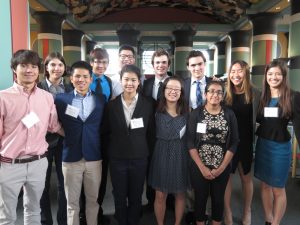
I’m really grateful for the opportunity we had to present at the 2nd Annual Smalley-Curl Institute Summer Research Colloquium! It was my first scientific poster presentation, so I definitely learned a lot. I enjoyed the experience, and wasn’t quite expecting to have so many people to constantly talk to. Two hours of presentation passed by in what felt like minutes because I was pretty much always talking to someone. It really was difficult to both answer specific technical questions from students in my field while also addressing broader, big-picture points from other audience members. All of this was definitely a great learning experience, and I was happy to communicate how much I learned and explored this summer to many people. My PI from Rice stopped by my poster for a while and had many comments about my research. Later that week, he gave me a lot of feedback, and I realize I had to do a lot better at capturing the big-picture of my research and making it accessible to people who don’t have background in solid-state physics or related fields. I also realized that I had spent a lot of time making my poster really aesthetically pleasing without taking enough time to ensure that the organization was simple and accessible. I was pleased with how I did at the poster presentation, though, considering that it was my first poster. Next time, I hope to focus on creating a more coherent story and simplifying the organization of my thoughts. For this poster, my work was essentially representative of a single figure in a long paper, so I spent much of the background section talking about the rest of that paper. This was kind of problematic because that background was very heavy and didn’t seem to clearly relate to my current research, so next time I hope to simplify my communication and focus.
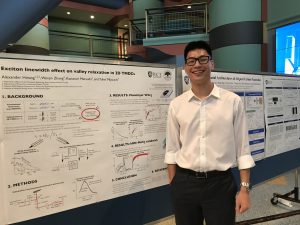
The most important takeaways from Nakatani RIES
When speaking to a family member about Nakatani RIES, I’d emphasize the amount of personal growth that this experience gave me. Being outside of the country for a longer period of time than most Americans will ever experience made me mature in ways I never would have expected. Living in Japan helped me truly understand what “culture” means — there are many layers to culture that one would never fully experience unless given the opportunity to immerse themselves in it for an extended period of time. At the same time, I learned so much about my own American culture and Asian-American identity. Sarah tells us this a lot, but it deserves repeating: in experiences like these, one learns just as much about themselves as they learn about the country they are visiting. In this time abroad, I learned and thought about my values, my goals, and my dreams. Sorry if this sounds cliché, but I really cannot understate how much I’ve cherished this opportunity from Nakatani RIES.
When speaking to a professor about Nakatani RIES, I’d talk about the awesome growth I experienced as a scientist and young researcher. In Japan, where undergraduate research is not common (I was the first undergraduate to ever work in my host lab), from day one, I was expected to work hard on a serious research project. Being in a large, established lab with a lot of equipment and human resources allowed me to be more independent on a research project than ever before. I learned to work hard and work in a disciplined fashion. I pushed myself outside my comfort zone and am proud of how much I learned about a previously unknown research field, TMDC material physics. Just the simple ability to confidently recall the important papers, important researchers, and key experiments/results in this field is something I’m really proud of myself before. Before this summer, I was definitely daunted by the task of learning all this new physics, but after this summer, I feel like I summited a mountain. I would say that this summer was instrumental in making me a more confident researcher, and has absolutely encouraged me to continue on a path towards graduate school.
When speaking to an employer about Nakatani RIES, I would emphasize the amount of cross-cultural communication that I learned how to navigate while abroad in one of the most economically-dominant countries in the world. I learned that culture is a real thing, and cultural barriers can be huge in working in teams across the world. This sort of global collaboration is becoming more and more common, and it was incredible to experience first-hand the challenges and rewards this sort of teamwork can bring.
When speaking to a student at Rice about Nakatani RIES, I’d simply tell them that this was the best summer of my life, hands down. I’d implore them to explore and see the world, make real friends and connections across the globe, and push themselves outside their comfort zone.
Clearly, being a part of Nakatani RIES had a remarkable impact on my personal development. Moving forward, I have more hope in my dream of pursuing graduate school in the area of Applied Physics and investigating solutions to societal challenges such as renewable energy, biomedical physics, and next-generation information. I have more desire to appreciate my culture and Asian heritage, and really look forward to improving my Chinese abilities by taking classes. I also now have a lot of interest in exploring fellowships such as the Fulbright Scholar Program, where I could again pursue a research or civically engaged project abroad.
Follow-on Project
For my follow-on project, I helped advertise the Nakatani RIES program to freshmen and sophomores at the Discover Research fair at Rice University this August. I talked to many freshmen about the unique opportunity this program provides and the amazing personal and scientific growth I experienced as a result of it. I was very happy to introduce many students to Nakatani who never would have heard of it otherwise.
I am also considering presenting my research at the Gulf Coast Undergraduate Research Symposium and/or a bigger meeting such as an American Physical Society March Meeting.
Finally, my lab at Rice does a lot of work with the Optical Society of America student chapter, which does a lot of outreach to local Houston high schools. I am working with them to see if I can talk to high schoolers about the value of STEM and the availability of incredible and affordable summer research experiences.
Tips for Future Participants
Pre-departure
- Make a list of the top things you want to see/do in Tokyo (e.g. Ghibli Museum requires buying tickets in advance) and around your host city (e.g. buy a rail pass and explore an entire area).
- In your free time/on the plane, enjoy parts of Japanese pop culture (manga, anime, etc.) that are a huge part of what you’ll see and experience in Japan. It’ll help you enjoy pop-culture-heavy areas like Akihabara in Tokyo and relate to the Japanese students you meet.
- If you don’t have background in the research area of your lab, take some time to learn the fundamentals behind it (e.g. solid state physics, organic chemistry).
- Learn to program in MATLAB.
Orientation Program in Tokyo
- Don’t get sick. Get some rest.
- Again, take some time to learn the fundamentals of your research.
Mid-Program Meeting In Kyoto
- It’s much better to have 2-3 slides with a broad overview than try to squeeze a ton of information into 10 slides in 5 min.
- Take this time to reflect on your research experience so far and brainstorm ways you can make your experience better. Think about what’s gone well, what hasn’t gone well, and things you want to improve on.
Working With Your Research Lab
- Ask questions early and often.
- You may be expected to function as an almost independent researcher. Learn to live with frustration. Be creative. Generate ideas and questions on your own. Ask why you’re doing what you’re doing.
- Become friends with all the members in your lab, as this will not only help you with your research immensely but also your well-being as a whole. Living on your own can be a struggle, and your lab mates can be a great first point of contact as people who have likely gone through the exact same personal and academic struggles as you at some point.
Living in Your Research Host City
- Look for free Japanese classes that are often great places to meet not only Japanese people but other foreigners.
- This summer, I often really lived the research-only life and was at lab all day and night. This is great, but still, I wish I took more time to cook healthy meals, clean my room, and sleep — make sure to be disciplined about doing these necessities.
Japanese Language
- Learning kanji (Chinese characters used in the Japanese language) on a smartphone app is a fantastic way to pass time on trains, etc.
- Just speak with your Japanese friends in Japanese as much as possible, even if they answer in English at first.
